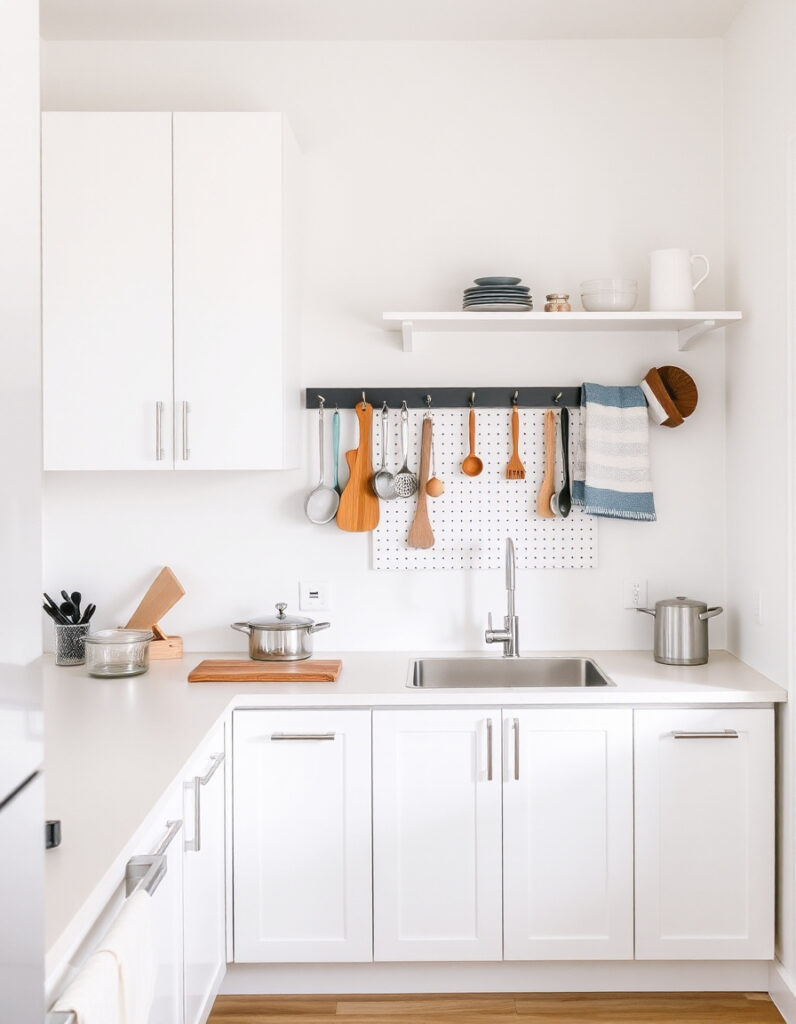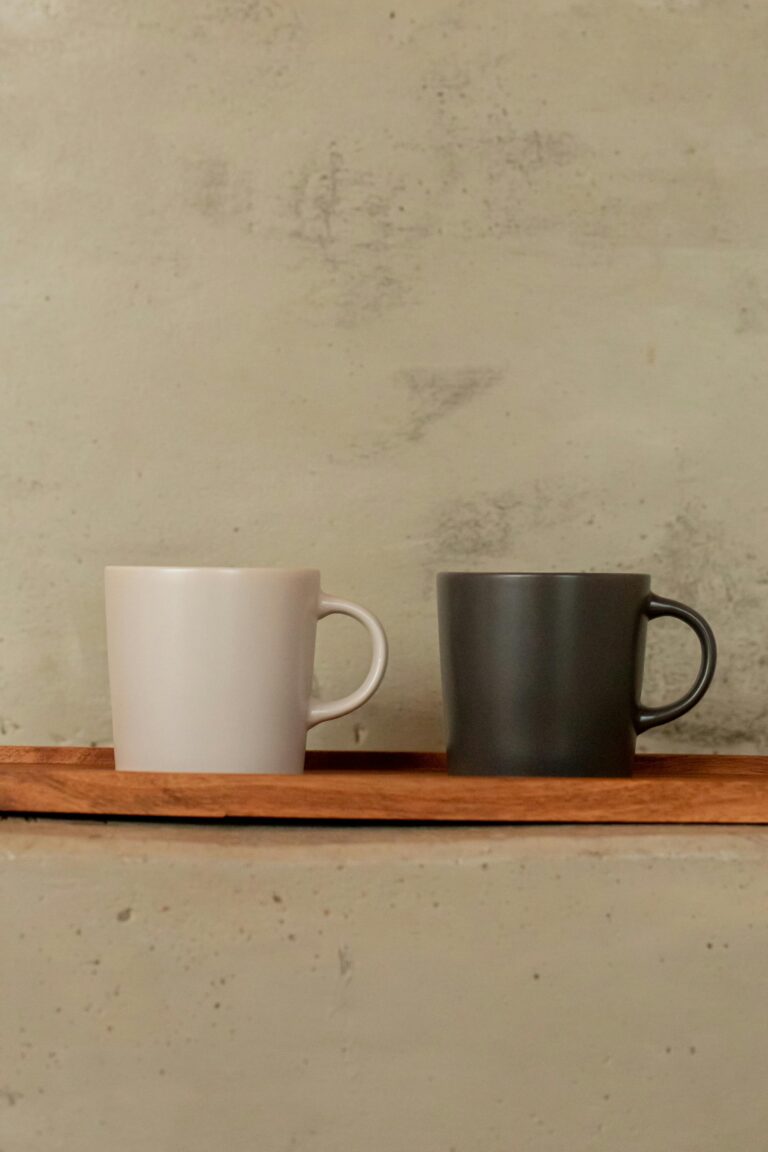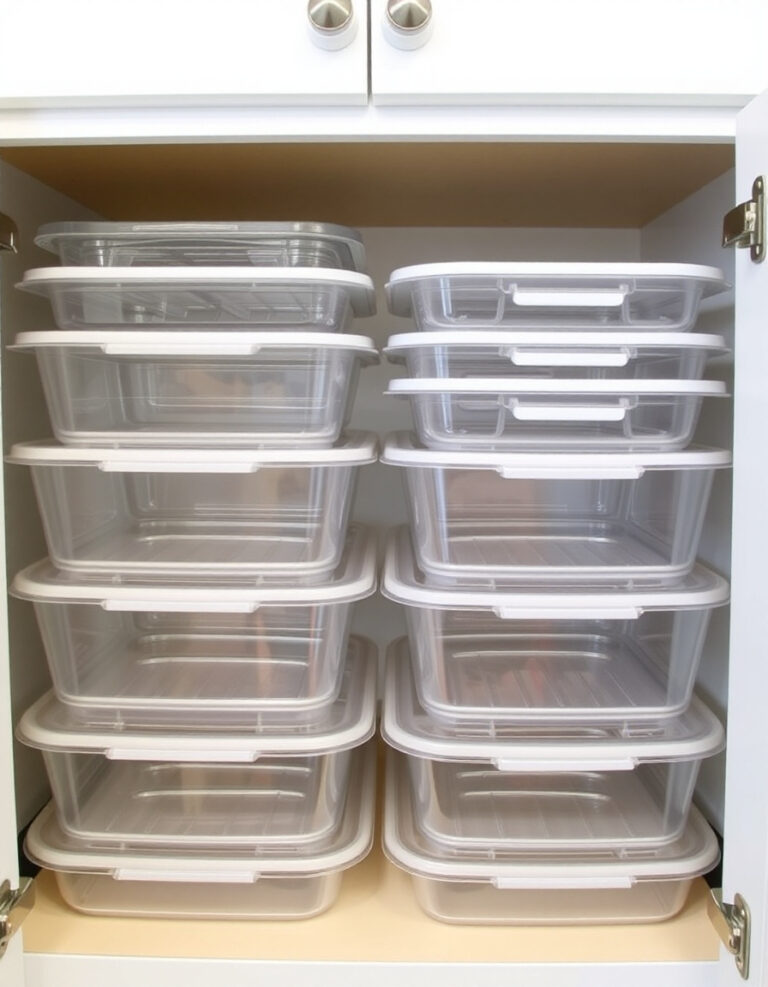Studio kitchens don’t leave much room for error. When cabinet space is limited, space really matters. Here’s what we’ll cover to help you maximize what you’ve got.
Why Studio Kitchen Organization Works Differently

Organizing a full-sized kitchen is one thing. A studio kitchen is another challenge entirely. Without the luxury of extra shelves, you need strategies that work with the space, not against it.
1. Maximize Vertical Wall Space Above and Below Cabinets
Cabinet tops and the space underneath upper cabinets often go unused. Mount a shelf or tension rod under your cabinets for mugs or wine glasses. Stack attractive storage baskets on top of cabinets for items you don’t use daily.
Wall-mounted magnetic strips hold knives and metal utensils without taking up drawer space. Install hooks on cabinet sides for measuring cups or dish towels.
2. Keep Kitchen Counters Nearly Empty for More Space
Clear counters create the illusion of more space. Store appliances you use less than twice a week in a cabinet or closet. A coffee maker and dish rack might stay out, but the blender and toaster can go away.
Use a tray or small basket to corral items like oil bottles and salt. Everything feels more contained, and you can move the whole setup when you need workspace.
3. Install a Kitchen Pegboard or Rail System
A pegboard gives you customizable storage that changes with your needs. Hang pots, pans, utensils, or even small shelves. Move hooks around as your kitchen tools change.
Rail systems with S-hooks work the same way. They keep your most-used tools visible and accessible. Just mount it on any empty wall space near your prep area.
Also Read: 6 Under-Sink Storage Ideas For Tiny Apartment Kitchens
4. Use Drawer Dividers to Maximize Cabinet Storage
Drawers can become messy fast without some structure. Add dividers or small bins to separate utensils, gadgets, and tools. You’ll find what you need faster and fit more in each drawer.
Expandable drawer organizers adjust to your drawer size. Use them for flatware, cooking tools, or even spices stored flat.
5. Store Pantry Items in Clear Containers
Clear containers let you see what you have at a glance. No more buying duplicate pasta or wondering if you’re out of rice. They also stack neatly and make the most of vertical cabinet space.
Label each container for quick identification. This system works well in cabinets or on open shelves where visual consistency matters.
6. Organize Kitchen Items by Task Zones
Group items by task, not by category. Keep coffee, filters, and mugs near the coffee maker. Store cooking oils, spices, and utensils near the stove.
This approach, called zone organization, cuts down on back-and-forth movement. You’ll work more efficiently in a small space.
7. Add a Rolling Kitchen Cart for Extra Storage
A slim rolling cart slides into tight spots and moves where you need it. Use it as a coffee station, extra prep surface, or overflow pantry. Many carts have shelves that hold surprising amounts.
Park it next to your counter when cooking, then roll it out of the way. It’s flexible storage that adapts to your routine.
Also See: 8 Counter Organization Rules For Kitchens With Small Space
8. Install a Wall-Mounted Pot Rack to Save Cabinet Space
Pots and pans take up serious cabinet real estate. A ceiling-mounted or wall-mounted rack frees up that space for other items. Choose a style that fits your studio’s aesthetic.
Even a simple grid with hooks works well. Hang your most-used cookware where you can reach it easily.
9. Use Cabinet Door Storage for Small Items
Cabinet doors offer hidden storage potential. Attach adhesive hooks for pot lids or measuring spoons. Mount a small wire rack for aluminum foil and plastic wrap.
Over-the-door organizers work too, but keep them slim. You don’t want them blocking shelves or making doors hard to close.
10. Rotate Seasonal Kitchen Items Out of Cabinets
Not everything needs to live in your kitchen year-round. Store holiday serving dishes, specialty baking tools, or extra glassware in a closet or under your bed. Swap items seasonally.
This keeps your active kitchen inventory lean. You’re only storing what you actually use regularly.
11. Choose Multi-Purpose Kitchen Tools
One good chef’s knife beats a full knife set. A pot that doubles as a mixing bowl saves space. Look for tools that handle multiple jobs.
Skip single-use gadgets unless you use them constantly. Every item should earn its spot in your limited storage.
Also Read: 7 Wall-Mounted Storage Solutions For Cramped Kitchens
12. Move Cleaning Supplies Out of the Kitchen
Cleaning products don’t have to live under the kitchen sink. Move them to a bathroom cabinet or hall closet. This frees up prime kitchen storage for food and cookware.
Keep just a dish soap and sponge under the sink. Everything else can live somewhere more spacious.
Small Kitchen Organization Mistakes to Avoid
Some organizing trends don’t suit studio kitchens. Rotating tray can waste corner space in shallow cabinets. Bulky storage containers may not fit your shelves. Measure before you buy any organizing product.
Avoid over-organizing with too many bins and dividers. Sometimes simple zones work better than complex systems.
Final Thoughts on Studio Kitchen Organization
A studio kitchen with minimal cabinets can still feel organized and functional. Focus on vertical space, multi-purpose tools, and keeping only what you use. Small adjustments add up to a kitchen that works smoothly. Try a few of these strategies and see what fits your space and style.
FAQs
How do I organize a kitchen with no pantry? Use a rolling cart, stackable bins, or a bookshelf as pantry storage. Keep items in clear containers and group them by category for easy access.
What should I keep on my kitchen counter in a studio? Only items you use daily, like a coffee maker or dish rack. Everything else should go in cabinets, on shelves, or in storage to keep counters clear.
How can I add more storage to a rental kitchen? Use removable solutions like adhesive hooks, tension rods, magnetic strips, and freestanding shelves or carts. Avoid drilling holes or making permanent changes.
Where should I store pots and pans in a small kitchen? Hang them on a wall-mounted rack, pegboard, or ceiling grid. You can also nest them inside each other in a deep cabinet with a vertical organizer.
How do I keep a small kitchen from feeling cluttered? Store items vertically, use clear containers, and keep counters mostly empty. Regularly remove items you don’t use and maintain zones for different tasks.



